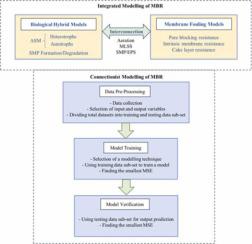Journal of Environmental Chemical Engineering ( IF 7.7 ) Pub Date : 2021-09-21 , DOI: 10.1016/j.jece.2021.106406 Hamideh Hamedi 1 , Omid Mohammadzadeh 1 , Seyedabbas Rasouli 1 , Sohrab Zendehboudi 1

|
Performance modeling of wastewater treatment systems has now become an attractive area of investigation for the design, analysis, and optimization of operations. Membrane bioreactor (MBR) is a complex system, composed of different processes such as biological process as well as membrane filtration process. Various models have been developed over the years to individually describe each of these processes. Activated sludge model no. 1 (ASM1) was introduced in 1987, primarily for the design and operation of the biological wastewater treatment processes for ammonia and organic matter removal. In 1995, ASM2 was proposed capturing the removal of phosphorus from wastewater. Finally in 1999, ASM3 was developed as a more accurate model to correct the deficiencies associated with ASM1. ASMs have been widely employed during the last decade to simulate the bioprocess/biomass kinetics in the MBR systems. To incorporate the membrane fouling phenomenon in the modeling approach as well as to better understand the individual and collective foulants, the ASM approaches were modified in 1989 by introducing a main foulant contributing to the membrane fouling phenomenon, the so-called soluble microbial products (SMP) concept. This represents the inception of the hybrid models. Mechanistic modeling of the MBR filtration process is mainly performed using resistance-in-series (RIS) model as one of the extensively used approaches with different subdivisions of total resistance corresponding to the fouling mechanisms. To further improve the knowledge about the system behavior, a combination of the hybrid models with fouling models (mostly RIS) known as integrated models was developed in 2002. Numerous studies have been subsequently devoted to utilizing the integrated models as a best-case scenario for forecasting the MBR process behavior. Moreover in recent years, connectionist tools such as artificial intelligence (AI) and machine learning (ML) have attracted significant attention as reliable modeling methods to predict complex processes associated with the membrane separation by providing linear and nonlinear relationships between the variables. In this paper, we provide a comprehensive review of the literature associated with biomass kinetics developments as well as membrane filtration modeling. A wide range of the models proposed for system optimization, from empirical/system identification to mechanistic/analytical mathematical models are reviewed in this paper. The challenges/limitations with the available models as well as recommendations for future work on MBR modeling and optimization are also highlighted.
中文翻译:

膜生物反应器系统生物质动力学和膜过滤模型的批判性回顾
废水处理系统的性能建模现在已成为设计、分析和优化操作的一个有吸引力的研究领域。膜生物反应器(MBR)是一个复杂的系统,由生物过程和膜过滤过程等不同过程组成。多年来已经开发了各种模型来单独描述这些过程中的每一个。活性污泥型号 1 (ASM1) 于 1987 年推出,主要用于去除氨和有机物的生物废水处理工艺的设计和操作。1995 年,ASM2 被提议用于从废水中去除磷。最后在 1999 年,ASM3 被开发为更准确的模型,以纠正与 ASM1 相关的缺陷。在过去十年中,ASM 被广泛用于模拟 MBR 系统中的生物过程/生物质动力学。为了将膜污染现象纳入建模方法并更好地了解个体和集体污染,ASM 方法在 1989 年进行了修改,引入了导致膜污染现象的主要污染物质,即所谓的可溶性微生物产物 (SMP)。 ) 概念。这代表了混合模型的开始。MBR 过滤过程的机械建模主要使用串联阻力 (RIS) 模型作为广泛使用的方法之一,具有与污垢机制相对应的不同总阻力细分。为了进一步提高对系统行为的了解,2002 年开发了混合模型与结垢模型(主要是 RIS)的组合,称为集成模型。随后,大量研究致力于利用集成模型作为预测 MBR 过程行为的最佳情况。此外,近年来,人工智能 (AI) 和机器学习 (ML) 等联结工具作为可靠的建模方法引起了极大的关注,通过提供变量之间的线性和非线性关系来预测与膜分离相关的复杂过程。在本文中,我们全面回顾了与生物质动力学发展以及膜过滤建模相关的文献。为系统优化提出的各种模型,本文综述了从经验/系统识别到机械/分析数学模型。还强调了可用模型的挑战/限制以及对未来 MBR 建模和优化工作的建议。



























 京公网安备 11010802027423号
京公网安备 11010802027423号